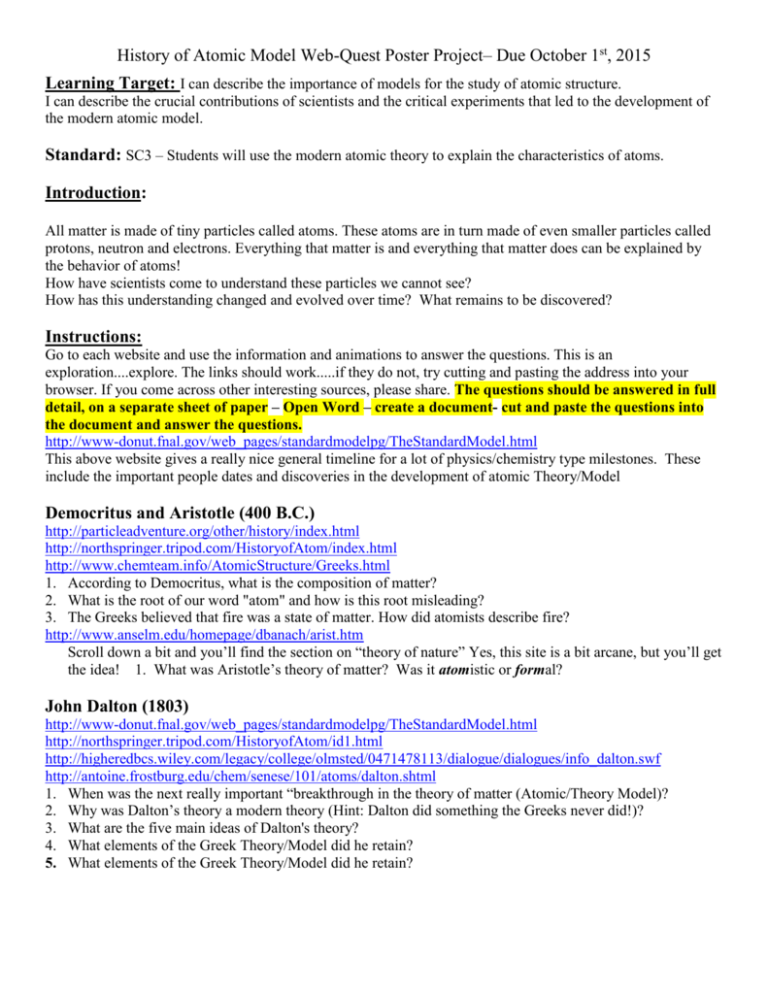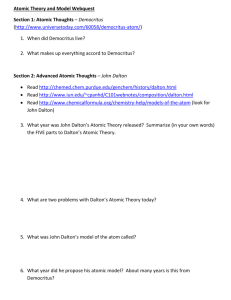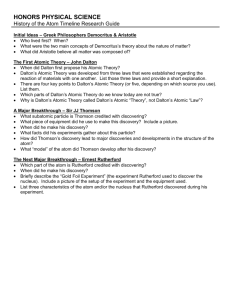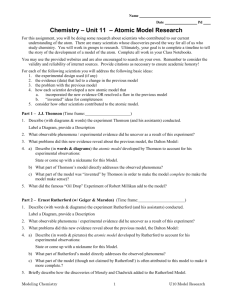Atomic Model Project
advertisement

History of Atomic Model Web-Quest Poster Project– Due October 1st, 2015 Learning Target: I can describe the importance of models for the study of atomic structure. I can describe the crucial contributions of scientists and the critical experiments that led to the development of the modern atomic model. Standard: SC3 – Students will use the modern atomic theory to explain the characteristics of atoms. Introduction: All matter is made of tiny particles called atoms. These atoms are in turn made of even smaller particles called protons, neutron and electrons. Everything that matter is and everything that matter does can be explained by the behavior of atoms! How have scientists come to understand these particles we cannot see? How has this understanding changed and evolved over time? What remains to be discovered? Instructions: Go to each website and use the information and animations to answer the questions. This is an exploration....explore. The links should work.....if they do not, try cutting and pasting the address into your browser. If you come across other interesting sources, please share. The questions should be answered in full detail, on a separate sheet of paper – Open Word – create a document- cut and paste the questions into the document and answer the questions. http://www-donut.fnal.gov/web_pages/standardmodelpg/TheStandardModel.html This above website gives a really nice general timeline for a lot of physics/chemistry type milestones. These include the important people dates and discoveries in the development of atomic Theory/Model Democritus and Aristotle (400 B.C.) http://particleadventure.org/other/history/index.html http://northspringer.tripod.com/HistoryofAtom/index.html http://www.chemteam.info/AtomicStructure/Greeks.html 1. According to Democritus, what is the composition of matter? 2. What is the root of our word "atom" and how is this root misleading? 3. The Greeks believed that fire was a state of matter. How did atomists describe fire? http://www.anselm.edu/homepage/dbanach/arist.htm Scroll down a bit and you’ll find the section on “theory of nature” Yes, this site is a bit arcane, but you’ll get the idea! 1. What was Aristotle’s theory of matter? Was it atomistic or formal? John Dalton (1803) http://www-donut.fnal.gov/web_pages/standardmodelpg/TheStandardModel.html http://northspringer.tripod.com/HistoryofAtom/id1.html http://higheredbcs.wiley.com/legacy/college/olmsted/0471478113/dialogue/dialogues/info_dalton.swf http://antoine.frostburg.edu/chem/senese/101/atoms/dalton.shtml 1. When was the next really important “breakthrough in the theory of matter (Atomic/Theory Model)? 2. Why was Dalton’s theory a modern theory (Hint: Dalton did something the Greeks never did!)? 3. What are the five main ideas of Dalton's theory? 4. What elements of the Greek Theory/Model did he retain? 5. What elements of the Greek Theory/Model did he retain? J.J. Thomson (1898) http://www.aip.org/history/electron/jjhome.htm Look at the introductory page and then scroll down to the table of content at the lower left. Go through the sections of the table of contents. http://www-outreach.phy.cam.ac.uk/camphy/electron/electron_index.htm http://www.aip.org/history/electron/jj1897.htm http://www.aip.org/history/electron/jjelectr.htm http://www-outreach.phy.cam.ac.uk/camphy/nucleus/nucleus1_1.htm 1. Why did the better part of a century pass between Thomson’s work and Dalton’s work? Was no one interested in researching atomic theory???? 2. What made Thomson’s work possible? 3. Describe a cathode ray tube. 4. How did Thomson use the cathode ray tube in his research? 5. Explain what was done in the 1897 experiments and what was learned from them. 6. What were the three hypotheses that came out of Thomson’s work? 7. How were these hypotheses received by other scientists? 8. How did Thomson’s findings revise Dalton’s Atomic Theory? 9. What was Thomson’s model called? http://www.chemteam.info/AtomicStructure/Disc-of-Electron-Intro.html http://www.iun.edu/~cpanhd/C101webnotes/modern-atomic-theory/rutherford-model.html 10. Describe and sketch Thomson’s model of the atom. What is wrong with the picture presented on the www.iun.edu page? Robert Millikan's Oil Drop Experiment (1908) http://g.web.umkc.edu/gounevt/Animations/Animations211/MillikanOilDropExp.swf http://www.wwnorton.com/college/chemistry/chemistry3/ch/02/chemtours.aspx http://www.montereymotiongraphics.com/example1.swf http://www.webassign.net/resources/serpse8/activeFigures/25.22.swf 1. Press the bulb of the atomizer and observe. Describe what happens to the oil drops. 2. Now turn on the circuit, by pressing the button on the bottom right so that it goes from reading OFF, to reading ON. Spray the atomizer again. Describe the behavior of the drops. 3. Now play with the voltage by changing the potential difference. Spray the atomizer and observe. Move the voltage up and down and observe the drops. Record the voltage that makes some of the drops stay suspended in the middle of the apparatus. 4. Based on the interaction between the oil drops and the electric field, what did Millikan conclude? Ernst Rutherford (1909) http://www.mhhe.com/physsci/chemistry/essentialchemistry/flash/ruther14.swf http://www.mhhe.com/physsci/chemistry/essentialchemistry/flash/ruther14.swf http://www.wwnorton.com/college/chemistry/chemistry3/ch/02/chemtours.aspx http://www.iun.edu/~cpanhd/C101webnotes/modern-atomic-theory/rutherford-model.html http://micro.magnet.fsu.edu/electromag/java/rutherford/ 1. Go to the http://micro.magnet.fsu.edu/electromag/java/rutherford/ site. What do you observe when the slit width is adjusted to 4.0 nm? 2. How did Rutherford’s experiment disprove Thomson’s model of the atom? 3. What new model did Rutherford propose? Sketch it. 4. Describe Rutherford’s experiment. 5. What is an alpha particle? 6. If Thomson’s model hade been correct, what did Rutherford expect to see happen? What did happen? 7. Why was Rutherford’s model called the planetary model? 8. What was wrong with Rutherford’s model? Why didn’t folks accept it? Bohr and Schrodinger Click on the following link: http://www.epa.gov/rpdweb00/understand/rutherford.html 1. Explain Bohr’s “planetary model”. Where are the neutrons and protons? Where are the electrons? 2. Complete the blanks with information from the site. Each orbit around the nucleus represents an ________________________. Electrons cannot exist between _________________. 3. What happens to the energy levels of the orbitals as you move further from the nucleus? 4. Bohr’s model was an improvement over the older models because he recognized that electrons had to be in _____________________ (____________________). 5. Bohr’s model needed to be improved upon because it did not work for atoms that were _______________ than Hydrogen. 6. Schrodinger predicted that electrons had electromagnetic energy, meaning that they can behave both like a ________________ and a _________________. 7. Instead of having electrons in specific orbits, they were placed in clouds in Schrodinger’s model. In the cloud model can scientists predict where an electron is? Explain. 8. Draw a picture of the Bohr model and the Schrodinger model below. James Chadwick (1931) http://www-outreach.phy.cam.ac.uk/camphy/neutron/neutron1_1.htm http://www.chemcases.com/2003version/nuclear/nc-01.htm http://www.nature.com/physics/looking-back/chadwick/index.html 1. Which subatomic particle did James Chadwick discover? Compare its mass to that of a proton. Murray Gell-Mann and George Zweig or Standard Model (1964) http://www.hyperhistory.com/online_n2/people_n2/science_n2/atomic_theory.html http://pdg.web.cern.ch/pdg/cpep/history/smt.html http://www.timerime.com/en/event/155601/Quarks/ - Please watch the short video clip http://physics.tutorvista.com/modern-physics/quark.html 1. What particle forms protons and neutrons? 2. How many up and down quarks are in a proton? In a neutron? 2. What technology allowed Gell-Mann and Zweig to discover quarks? 3. What is the binding particle that holds a quark together? 4. What forces hold the atom together? Your Project: Your Research You will research the scientists and experiments that have led to our current understanding of the atom and its properties. You will be responsible for becoming an expert on one of the atomic models (Your teacher will assign). You will then share your information and create a timeline of events. Your research will include the following: A.Biography of your scientist: When did this scientist live? What was his or her education and background? How did the views of the scientific community influence their views and work? What did they look like? Include a photo. B. Discovery of scientist: Year of discovery? What discovery is this scientist noted for? General historical facts about key scientists – Experiments (where appropriate) that were done by researchers in advancing our idea about the atom. Explanation of significance of experiments (where appropriate) C. Links, Animations, Labeled diagrams, or Graphics that illustrate experiments. Include such things as J. J. Thomson’s cathode ray tube experiments, Rutherford’s gold foil Experiment, Bohr model absorption and emission of photons, etc. D. Timeline: When did this discovery occur in relationship to other atomic models? How did this discovery change our view of the atom or its properties? How did it influence future research? Your Task • Teach Us - You will prepare a 3-5 minute presentation to the class with the results of your research. • Help Us Visualize - You will prepare a single poster (either poster board or virtual) to contribute to a class timeline of the discovery of the atom. Each poster in the timeline will note the date or period of the discovery, the major character and the advancement in our understanding of the atom that is associated with your assigned topic. Together, these posters should present a history of the atom. • Give Credit - Site websites and printed sources you use. Include a bibliography of at least three sources. Scoring Guide Biography of Scientist 5 Clear and complete. Photo Discovery of Scientist 5 All questions answered Timeline 5 Where does this discovery fit into the timeline? Visual Aid – Links, Animations, Graphics 5 Easy to see and relevant to audience understanding Organization 5 Presentation is planned and well-coordinated. Quality of work 5 Clear that best effort was made. Visually Pleasing Completeness 5 Covers all the main points accurately and completely. Presentation 10 Spoke Clearly and Conveys a clear understanding of the topic Sources Cited 5 Cites included — at least three sources Total Points 50 Questions answered in the web-quest 50 Name ___________________________ Date _____________________ Period____________ Comments:











